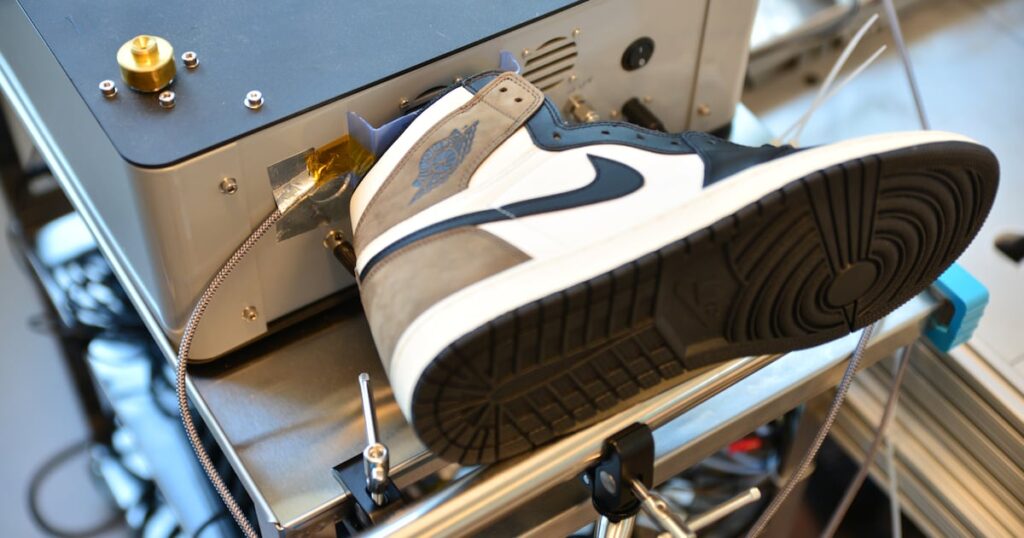[ad_1]
Your sneakers smell, though not in the way you might be thinking.
Even new, unworn shoes have a scent that emanates from their materials â leather and fibres in the upper, foam in the midsole, rubber in the outsoles, the glue holding it all together.
Osmo, a start-up that uses AI to map and create scents, believes these olfactory signatures are the key to being able to tell authentic shoes from fakes. If itâs right, it could provide a powerful new weapon to the resale industry, which devotes vast resources to authentication, and potentially to brands beyond footwear looking to protect their products.
A growing number of companies today are turning to AI as a tool in the battle against fakes, only where others have focused on spotting visual structures indiscernible to the human eye, Osmo has its eye â or nose â on smell. The idea isnât as strange as it sounds. Some human authenticators at companies like StockX will do sniff tests as one means of identifying knockoffs. Because factories producing counterfeits usually get their raw materials from different suppliers using different â often cheaper â ingredients or chemicals, their shoes can have markedly different bouquets.
Osmo is just using sophisticated sensors and AI to detect and analyse these aromas with far greater precision.
âA lot of the things that we want to look for and authenticate may not even have a perceptible odour,â said Rohinton Mehta, Osmoâs senior vice president of hardware and manufacturing. âItâs more like weâre trying to analyse chemical composition.â
The company has already conducted a pilot with a major sneaker resale company (it canât yet disclose which one) and had greater than 95 percent accuracy distinguishing fakes, according to Mehta. The number might have been higher if not for a couple instances where Osmo believed shoes the company said were genuine were actually counterfeits that hadnât been caught, he added.
The technology does have its limits, though. When dealing with AI, it always comes down to the data available.

For one thing, while sneakers and handbags may have strong, detectable scents, other items, like clothing, often donât, making them less likely candidates for the technology. But thatâs not the only constraint.
âOur method only works for high volume stuff, not for very rare things where only three were ever made,â Mehta said.
Thatâs because Osmo needs enough examples of authentic product to teach its AI what the genuine article smells like in order to differentiate it from any knockoff. How many it requires can vary, depending on how great the contrast is between real and fake.
In the pilot test, which looked at two Nike styles, Osmo only needed 10 pairs of genuine shoes and 10 pairs of counterfeits for one of the models. But for the other, it used 50 pairs of real shoes and 20 fakes. (To get a reading, you can put the shoe itself right up to the sensor â a piece of physical hardware thatâs been around for years â or insert its spout into the shoebox with the lid on.)
Needing numerous pairs of shoes to train the AI creates challenges. Ideally, a resale company using the technology would buy its real items directly from the brand, so there are no doubts about authenticity. But in the case of very limited drops where itâs hard to get one or two pairs of a shoe, let alone 10 or 20, that might not be possible.
Thereâs also significant investment required. Osmo imagines resale companies buying their own sensors so they can have them at their facilities. But like any scientific instrument, they need to be maintained and periodically recalibrated. The company would need to put in place a software infrastructure as well, and it would have to train the AI any time it has a new product it needs to authenticate. For these reasons, itâs unlikely a resale company could use the technology to test every single product.
But thatâs not to say the method is only valuable under those circumstances. Itâs the edge cases where Mehta sees the technology making the difference. About 80 percent of the time, it should be relatively easy to identify genuine items using standard methods like examining physical markers, he said. Another 15 percent of the time it will be possible to reliably catch fakes with techniques like data analytics to spot risky sellers. Itâs the remaining 5 percent, where those measures have proved inconclusive, in which Osmo can prove its value.
The technology could additionally be used for occasional audits on certain products or on items from high-volume sellers to ensure knockoffs arenât slipping through the cracks.
The trouble with this approach, and authentication more generally, is that the authenticators are always trying to identify markers of genuine products on their own, after the items have entered the marketplace. Meanwhile, dupes just keep getting better, making their jobs ever harder. But brands have started working with companies to embed signifiers of authenticity into their products during manufacturing. LVMHâs Patou, for instance, partnered with the online wholesale platform Ordre to add whatâs essentially a digital fingerprint to some of its bags, allowing anyone to verify their authenticity with an app.
Osmo similarly imagines brands being able to integrate odourless molecules that it creates into products, offering unmistakable verification of their origins. They could mix it into ingredients like glue, and could possibly even add it to clothing, according to Mehta, making it eligible for this form of authentication. And because Osmo would invent the molecules itself, counterfeiters wouldnât know what to look for, even if they analysed the item.
âItâs not in any library, but we will tune our detectors to detect this,â Mehta said. âThat becomes the killer app.â
Now Osmo just needs to convince brands that its idea passes the smell test.
[ad_2]
Source link

